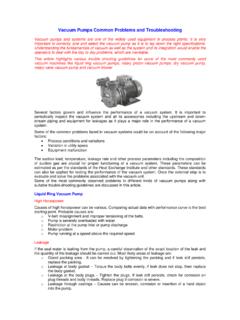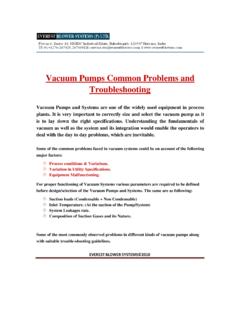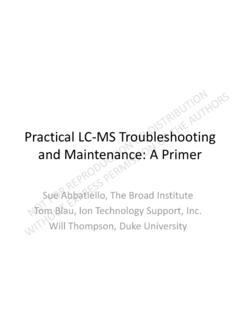Transcription of Troubleshooting Steam Surface Condensers
1 Troubleshooting Steam Surface Condensers Progressive Thermal Engineering all rights reservedPage 1 Troubleshooting Steam Surface CondensersHTS Forum12 September 2012 Steam Condenser Troubleshooting What is a Steam Surface condenser? Troubleshooting tools Is there a problem? Fault diagnosis Locating air leaks Condenser monitoringTroubleshooting Steam Surface Condensers Progressive Thermal Engineering all rights reservedPage 2 What is a Surface Condenser?WorkTurbineCondenserSteamCWWha t Does it Do? Condenses the exhaust Steam Rejects the latent heat at the lowest practical temperature Condenses under vacuum By creating vacuum , the condenser increases the efficiency of the turbine The condenser also performs some other important functionsTroubleshooting Steam Surface Condensers Progressive Thermal Engineering all rights reservedPage 3 Condenser Temperature ProfileTemperature, CDuty, kWCondenser dutyTemperature approachCW outCW inTsat TQ = U A T , if U and A are large, T can be small vacuumTypical CondensersRound condenser(up to about 3m diameter)Rectangular condenser(for larger units)
2 Troubleshooting Steam Surface Condensers Progressive Thermal Engineering all rights reservedPage 4 Condenser vacuum pumps Condensers are provided with vacuum pumps /ejectors The condenser creates the vacuum , NOT the vacuum pump vacuum pumps are there to extract air and pump it up to atmospheric pressure A startup ejector ( hogger ) is provided to create a rough vacuum in order to start the turbineCondenser VentingWaterboxCondensateCooling WaterLP SteamCooling WaterHotwellAir PumpTubesheetTube BundleShell / HoodTroubleshooting Steam Surface Condensers Progressive Thermal Engineering all rights reservedPage 5 Troubleshooting ToolsIs There a Problem?
3 Plant operator is typically concerned about turbine exhaust pressure First task is to establish whether the exhaust pressure is higher than expected Two issues: The plant measurement may not be accurate The turbine exhaust pressure will naturally vary with plant load and CW temperatureTroubleshooting Steam Surface Condensers Progressive Thermal Engineering all rights reservedPage 6 Case x 660MW generating units, turbine exhaust pressure (kPa) by unit:CW temperature = 25 C123456 Comments?Condenser Performance CurveTroubleshooting Steam Surface Condensers Progressive Thermal Engineering all rights reservedPage 7 Identifying Faults Three most common causes of condenser performance problems: Air accumulation in condenser Cooling water fouling Reduced cooling water flow Unfortunately, all have the same effect on condenser performance: Increase in turbine exhaust pressureCondenser Temperature ProfileTemperature, CDuty, kWCondenser dutyTemperature approachCW outCW inTsat TWhat is the response to the three most common faults?
4 Troubleshooting Steam Surface Condensers Progressive Thermal Engineering all rights reservedPage 8 Effect of Air in Steam Space No air Steam condenses easily Minimal sub-cooling Air blanket Steam must diffuse Sub-coolingThe presence of air reduces the heat transfer rateFault Diagnosis To differentiate between the various causes of high turbine exhaust pressure, examine temperatures, not pressure: CW flow reduction is indicated by increase in CW temperature rise Fouling is indicated by increase in temperature approach (Tsat CWout) Air accumulation is indicated by increase in temperature approach andincreased T between Tsatand condensate temperatureTroubleshooting Steam Surface Condensers Progressive Thermal Engineering all rights reservedPage 9 Confirming and Fixing Faults Reduction in cooling water flow is caused by fouling or a pump fault Fouling can be confirmed by inspection (most Condensers have divided waterboxes) Air accumulation is a more complex issue For air to accumulate.
5 Vent rate too low ( vacuum pump fault) Ingress rate too high (air leak) vacuum Pump Faults Generally rare, although original specification may be deficient For LRVPs check seal water temperature For Steam ejectors check motive Steam pressure (too high or too low) Detailed Troubleshooting outside scope of this presentationTroubleshooting Steam Surface Condensers Progressive Thermal Engineering all rights reservedPage 10 Air Leaks Some in-leakage is expected (hence the vacuum pump) vacuum pump is usually over-specified (especially if to HEI Standard) Once excess capacity is used, any additional in-leakage will cause turbine exhaust pressure to rise vacuum boundary must be maintainedAir Leakage PointsPITurbineCondenserTurbine shaft sealsTurbine burst discInstrument connectionsValve stemsVacuum breakerManway sealsCEP sealsExpansion jointTroubleshooting Steam Surface Condensers Progressive Thermal Engineering all rights reservedPage 11 Air Leak Detection Methods Many methods exist Online methods.
6 Feathers / Smoke / Candles Ultrasonics Helium testing Halogen testing Offline method water fill test Online testing with tracer gases is the most successful approachTraditional Methods? Troubleshooting Steam Surface Condensers Progressive Thermal Engineering all rights reservedPage 12 Tracer Gas TestingDetectorAir pumpTracer Gas Testing - Tips Always check the detector is working before you start Avoid false indications: Helium: work from top to bottom Halogen: work from bottom to top Time the response Consider testing under low load conditions: The vacuum boundary is more extensive at low loadsTroubleshooting Steam Surface Condensers Progressive Thermal Engineering all rights reservedPage 13 Case Study 200MW electrical generation unit in Ireland High turbine exhaust pressure on startup after outage, close to turbine trip point Outage scope had included: Condenser cleaning LP turbine rotor removal Heat balance indicates full CW flow Hotwell temperature inconclusiveCase Study - Actions Evidence suggests air leak High probability of leak at turbine shaft seals Helium testing ordered to confirm diagnosis.
7 Warranty issue Shutdown required to repair Which shaft seal is leaking? Other leaks? Troubleshooting Steam Surface Condensers Progressive Thermal Engineering all rights reservedPage 14 Case Study - Results Leakage at both turbine shaft seals confirmed Additional leakage also found at: Turbine bursting disc Cracked weld on pipe Plugged connection on condenser shell Resolution of non-shaft leaks moved turbine pressure away from trip point without shutdownLeak LocationsTurbine burst discCracked weldShaft sealPlugged connectionTroubleshooting Steam Surface Condensers Progressive Thermal Engineering all rights reservedPage 15 Condenser Monitoring Critical situations can be avoided by regular monitoring Monitoring pressure not very useful Monitor key temperature differences: (CWout CWin) (Tsat CWout) (Tsat Thotwell) Perform vacuum decay testing Isolate vacuum pump and measure rate of pressure increase



